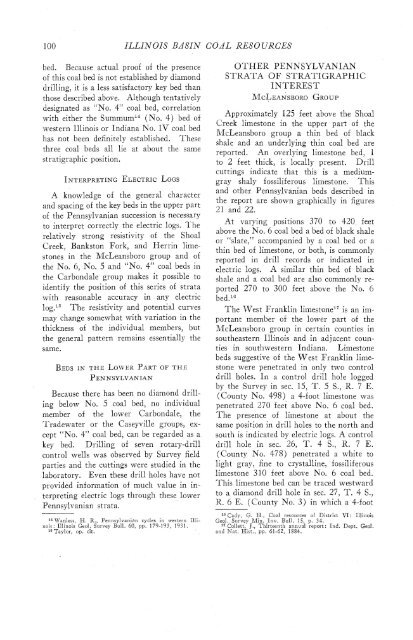subsurface geology and coal resources of the pennsylvanian system ...
subsurface geology and coal resources of the pennsylvanian system ...
subsurface geology and coal resources of the pennsylvanian system ...
Create successful ePaper yourself
Turn your PDF publications into a flip-book with our unique Google optimized e-Paper software.
100 ILLINOIS BASIN COAL RESOURCES<br />
bed. Because actual pro<strong>of</strong> <strong>of</strong> <strong>the</strong> presence OTHER PENNSYLVANIAN<br />
<strong>of</strong> this <strong>coal</strong> bed is not established by diamond STRATA OF STRATIGRAPHIC<br />
drilling, it is a less satisfactory key bed than<br />
INTEREST<br />
those described above. Although tentatively MCLEANSBORO GROUP<br />
designated as "No. 4" <strong>coal</strong> bed, correlation<br />
Approximately<br />
with ei<strong>the</strong>r <strong>the</strong> S~rnmurn'~ (No. 4)<br />
125 feet above <strong>the</strong> Shoal<br />
bed <strong>of</strong><br />
Creek limestone in <strong>the</strong> upper part <strong>of</strong> <strong>the</strong><br />
western Illinois or Indiana No. IV <strong>coal</strong> bed<br />
~IcLeansboro group a thin bed <strong>of</strong> black<br />
has not been definitely established. These<br />
shale <strong>and</strong> an underlying thin <strong>coal</strong> bed are<br />
three <strong>coal</strong> beds all lie at about <strong>the</strong> same<br />
reported. An overlying limestone bed, 1<br />
stratigraphic position.<br />
to 2 feet thick, is locally present. Drill<br />
cuttings indicate that this is a mediumgray<br />
shaly f ossiliferous limestone. This<br />
<strong>and</strong> o<strong>the</strong>r Pennsylvanian beds described in<br />
<strong>the</strong> report are shown graphically in figures<br />
21 <strong>and</strong> 22.<br />
At varying positions 370 to 420 feet<br />
above <strong>the</strong> No. 6 <strong>coal</strong> bed a bed <strong>of</strong> black shale<br />
or "slate," accompanied by a <strong>coal</strong> bed or a<br />
thin bed <strong>of</strong> limestone, or both, is commonly<br />
reported in drill records or indicated in<br />
A knowledge <strong>of</strong> <strong>the</strong> genesal character<br />
<strong>and</strong> spacing <strong>of</strong> <strong>the</strong> key beds in <strong>the</strong> upper part<br />
<strong>of</strong> <strong>the</strong> Pennsylvanian succession is necessary<br />
to interpret correctly <strong>the</strong> electric logs. 'The<br />
relatively strong resistivity <strong>of</strong> <strong>the</strong> Shoal<br />
Creek, Bankston Fork, <strong>and</strong> Herrin limestones<br />
in <strong>the</strong> McLeansboro group <strong>and</strong> <strong>of</strong><br />
<strong>the</strong> No. 6, No. 5 <strong>and</strong> "No. 4" <strong>coal</strong> beds in<br />
<strong>the</strong> Carbondale group makes it possible to<br />
identify <strong>the</strong> position <strong>of</strong> this series <strong>of</strong> strata<br />
with reasonable accuracy in any electric<br />
log." The resistivity <strong>and</strong> potential curves<br />
may change somewhat with variation in <strong>the</strong><br />
thickness <strong>of</strong> <strong>the</strong> individual members, but<br />
<strong>the</strong> general pattern remains essentially <strong>the</strong><br />
same.<br />
BEDS IN THE LOVV'ER FART<br />
PENNSYLVANIAN<br />
OF THE<br />
Because <strong>the</strong>re has been no diamond drilling<br />
below No. 5 <strong>coal</strong> bed, no individual<br />
member <strong>of</strong> <strong>the</strong> lower Carbondale, <strong>the</strong><br />
Tradewater or <strong>the</strong> Caseyville groups, except<br />
"No. 4" <strong>coal</strong> bed, can be regarded as a<br />
key bed. Drilling <strong>of</strong> seven sotary-drill<br />
control wells was observed by Survey field<br />
parties <strong>and</strong> <strong>the</strong> cuttings were studied in <strong>the</strong><br />
laboratory. Even <strong>the</strong>se drill holes have not<br />
provided information <strong>of</strong> much value in interpreting<br />
electric logs through <strong>the</strong>se lower<br />
Pennsylvanian strata.<br />
t4 Wanless, H. R., Pennsylvanian cycles in western Illi-<br />
1101s : Illinois Geol. Survey Bull. 60, pp. 179-193, 1931.<br />
l5 Taylor, op. cit.<br />
electric logs. A similar thin bed <strong>of</strong> black<br />
shale <strong>and</strong> a <strong>coal</strong> bed are also commonly reported<br />
270 to 300 feet above <strong>the</strong> No. 6<br />
bed."<br />
The West Franklin limestone17 is an important<br />
member <strong>of</strong> <strong>the</strong> lower part <strong>of</strong> <strong>the</strong><br />
McLeansboro group in certain counties in<br />
sou <strong>the</strong>astern Illinois <strong>and</strong> in adjacent coun-<br />
ties in southwestern Indiana. Limestone<br />
beds suggestive <strong>of</strong> <strong>the</strong> West Franklin limestone<br />
were penetrated in only two control<br />
drill holes. In a control drill hole logged<br />
by <strong>the</strong> Survey in sec. 15, T. 5 S., R. 7 E.<br />
(County No. 498) a 4-foot limestone was<br />
penetrated 270 feet above No. 6 <strong>coal</strong> bed.<br />
The presence <strong>of</strong> limestone at about <strong>the</strong><br />
same position in drill holes to <strong>the</strong> north <strong>and</strong><br />
south is indicated by electric logs. A control<br />
drill hole in sec. 26, T. 4 S., R. 7 E.<br />
(County No. 478) penetrated a white to<br />
light gray, fine to crystalline, fossiliferous<br />
limestone 310 feet above No. 6 <strong>coal</strong> bed.<br />
This limestone bed can be traced westward<br />
to a diamond drill hole in sec. 27, T. 4 S.,<br />
R. 6 E. (County No. 3) in which a 4-foot<br />
10 Cady, G. H., Coal <strong>resources</strong> <strong>of</strong> District VI: Illinois<br />
Geol. Survey Min. Inv. Bull. 15, p. 31.<br />
17 Collett, J., Thirteenth annual report: Ind. Dept. Geol.<br />
<strong>and</strong> hiat. Hist., pp. 61-62, 1884.
















